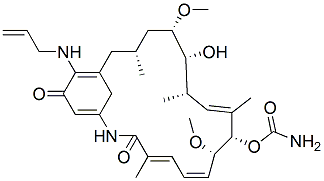All AbMole products are for research use only, cannot be used for human consumption.

17-AAG (Tanespimycin) is a less toxic analogue of the geldanamycin which binds to Hsp90 and alters its function. HSP90 client proteins play important roles in the regulation of the cell cycle, cell growth, cell survival, apoptosis, and oncogenesis. 17-AAG (Tanespimycin) binds into the ATP binding pocket in Hsp90 and induces the degradation of proteins that require this chaperone for conformational maturation. 17-AAG (Tanespimycin) inhibits Akt activation and expression in tumors and synergizes with a number of antitumor agents such as taxol, cisplatin, and UCN-014.

Pharmaceuticals (Basel). 2025 Jan 03.
Identification of a New Pentafluorosulfanyl-Substituted Chalcone with Activity Against Hepatoma and Human Parasites
17-AAG (Tanespimycin) purchased from AbMole
| Molecular Weight | 585.69 |
| Formula | C31H43N3O8 |
| CAS Number | 75747-14-7 |
| Solubility (25°C) | DMSO 40 mg/mL |
| Storage | 2-8°C, protect from light |
| Related HSP Products |
|---|
| Potassium palmitate-13C16
Potassium palmitate-13C16 can induce the expression of glucose-regulated protein 78 (GRP78) and CCAAT/enhancer binding protein homologous protein (CHOP) in in mouse granulosa cells. |
| NCT-58
NCT-58 is a potent inhibitor of C-terminal HSP90. |
| Gedunin
Gedunin is a limonoid with anti-cancer, anti-viral, anti-inflammatory and insecticidal activities. |
| VER-49009
VER-49009 is a Hsp90 inhibitor, with an IC50 of 25 nM and a Kd of 78 nM. |
| YUM70
YUM70 is a potent and selective inhibitor of glucose-regulated protein 78 (GRP78), with an IC50 of 1.5 μM for inhibiting GRP78 ATPase activity. YUM70 induces endoplasmic reticulum stress-mediated apoptosis in pancreatic cancer. |
All AbMole products are for research use only, cannot be used for human consumption or veterinary use. We do not provide products or services to individuals. Please comply with the intended use and do not use AbMole products for any other purpose.


Products are for research use only. Not for human use. We do not sell to patients.
© Copyright 2010-2024 AbMole BioScience. All Rights Reserved.
